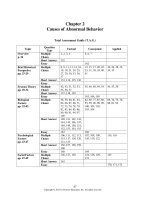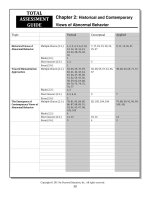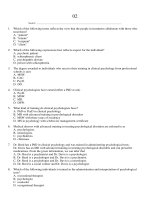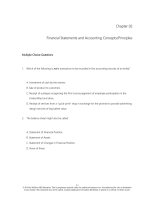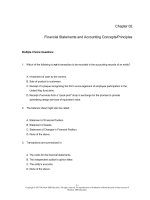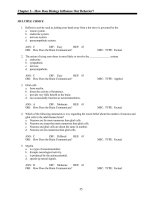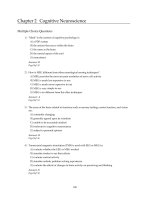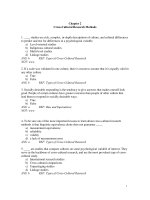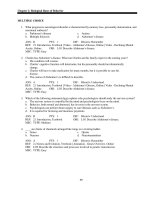What is psychology international edition 3rd edition pastorino test bank
Bạn đang xem bản rút gọn của tài liệu. Xem và tải ngay bản đầy đủ của tài liệu tại đây (573.27 KB, 47 trang )
Chapter 2—How Does Biology Influence Our Behavior?
MULTIPLE CHOICE
1. Reflexive activity such as jerking your hand away from a hot stove is governed by the
a. rescue system.
b. endocrine system.
c. nervous system.
d. parasympathetic system.
ANS: C
DIF: Easy
REF: 43
OBJ: How Does the Brain Communicate?
MSC: TYPE: Factual
2. The action of tying your shoes is most likely to involve the _______________ system.
a. endocrine
b. sympathetic
c. nervous
d. parasympathetic
ANS: C
DIF: Easy
REF: 43
OBJ: How Does the Brain Communicate?
MSC: TYPE: Applied
3. Glial cells
a. form myelin.
b. direct the activity of hormones.
c. provide very little benefit to the brain.
d. can occasionally function as neurotransmitters.
ANS: A
DIF: Moderate
REF: 43
OBJ: How Does the Brain Communicate?
MSC: TYPE: Factual
4. Which of the following statements is true regarding the recent belief about the number of neurons and
glial cells in the adult human brain?
a. Neurons are far more numerous than glial cells.
b. Neurons are somewhat more numerous than glial cells.
c. Neurons and glial cells are about the same in number.
d. Neurons are less numerous than glial cells.
ANS: C
DIF: Difficult
REF: 43
OBJ: How Does the Brain Communicate?
MSC: TYPE: Factual
5. Myelin
a. is a type of neurotransmitter.
b. disrupts neurological activity.
c. is produced by the action potential.
d. speeds up neural signals.
ANS: D
DIF: Moderate
REF: 43
OBJ: How Does the Brain Communicate?
55
MSC: TYPE: Factual
6. If you had a disease called multiple sclerosis, what symptoms would you likely exhibit?
a. Difficulty with voluntary movement
b. Some vision loss
c. Numbness
d. All of these choices
ANS: D
DIF: Moderate
REF: 43-44
OBJ: How Does the Brain Communicate?
MSC: TYPE: Applied
7. Without glial cells, your brain would
a. not function differently than otherwise.
b. be unable to communicate within itself.
c. repair itself more rapidly than normal in the case of an injury.
d. send information more slowly.
ANS: D
DIF: Moderate
REF: 43
OBJ: How Does the Brain Communicate?
MSC: TYPE: Conceptual
8. If the neural impulses generated in your brain are not traveling as fast as normal, it may be because
a. you don’t have enough substance P.
b. you have too much serotonin.
c. your sympathetic nervous system is overactive.
d. you do not have enough myelin cells.
ANS: D
DIF: Moderate
REF: 43
OBJ: How Does the Brain Communicate?
MSC: TYPE: Conceptual
9. Which of the following involves myelin loss, causing neural impulses to travel around in the brain
without making it to their destinations?
a. Depression
b. Multiple sclerosis
c. Parkinson’s disease
d. Alzheimer’s disease
ANS: B
DIF: Difficult
REF: 43-44
OBJ: How Does the Brain Communicate?
MSC: TYPE: Factual
10. The part of the neuron that receives signals from other neurons is(are) the
a. axon.
b. dendrites.
c. cell body.
d. synaptic cleft.
ANS: B
DIF: Easy
REF: 44
OBJ: How Does the Brain Communicate?
56
MSC: TYPE: Factual
11. Dr. Adelman is biological psychologist who is most interested in studying the part of the neuron that
receives input from other neurons. He is most likely to focus on which of the following?
a. Myelin
b. Axon bulbs
c. Dendrites
d. Glial cells
ANS: C
DIF: Easy
REF: 44
OBJ: How Does the Brain Communicate?
MSC: TYPE: Applied
12. Within a single neuron, dendrites are ______________ and axon bulbs are ________________.
a. active in communication; active in cell metabolism
b. myelinated; unmyelinated
c. at the beginning; at the end
d. much smaller; much larger
ANS: C
DIF: Easy
REF: 44
OBJ: How Does the Brain Communicate?
MSC: TYPE: Factual
13. The axons of neurons in the brain are typically
a. longer than those in the peripheral nervous system.
b. shorter than those in the peripheral nervous system.
c. about the same size as those in the peripheral nervous system.
d. extremely variable in length, with some being very long and others very short.
ANS: B
DIF: Difficult
REF: 44-45
OBJ: How Does the Brain Communicate?
MSC: TYPE: Factual
14. The gap between adjacent neurons is called the
a. synapse.
b. myelin sheath.
c. dendrite space.
d. cellular gap.
ANS: A
DIF: Easy
REF: 45
OBJ: How Does the Brain Communicate?
MSC: TYPE: Factual
15. The vesicles at the end of an axon contain
a. sodium (Na+) ions.
b. neurotransmitters.
c. myelin.
d. DNA.
ANS: B
DIF: Moderate
REF: 45
OBJ: How Does the Brain Communicate?
57
MSC: TYPE: Factual
16. Each neuron in the brain can potentially synapse with up to ______________ other neuron(s).
a. only 1
b. 10
c. 1,000
d. 10,000
ANS: D
DIF: Moderate
REF: 45
OBJ: How Does the Brain Communicate?
MSC: TYPE: Factual
17. In terms of the function of dendrites, they are most like the _________________ in your home.
a. front door
b. back door
c. kitchen
d. bedroom
ANS: A
DIF: Difficult
REF: 44
OBJ: How Does the Brain Communicate?
MSC: TYPE: Conceptual
18. In terms of the function of axon bulbs, they are most like a(n) _______________ in a building.
a. entrance
b. exit
c. office
d. drinking fountain
ANS: B
DIF: Difficult
REF: 45
OBJ: How Does the Brain Communicate?
MSC: TYPE: Conceptual
19. Without an axon, a neuron would not be able to
a. receive neural impulses from other neurons.
b. duplicate itself.
c. direct the development of the neuron.
d. send neural impulses to other neurons.
ANS: D
DIF: Moderate
REF: 44
OBJ: How Does the Brain Communicate?
MSC: TYPE: Conceptual
20. A neuron’s DNA exists within its
a. cell body.
b. dendrites.
c. axon.
d. axon bulb.
ANS: A
DIF: Moderate
REF: 44
OBJ: How Does the Brain Communicate?
58
MSC: TYPE: Factual
21. If your neurosurgeon were able to take a neuron out of your brain and examine it, she would most
likely find that
a. its axon would be very short.
b. it would have two cell bodies.
c. it would have more than one axon.
d. its cell body would not have any dendrites attached to it.
ANS: A
DIF: Moderate
REF: 44-45
OBJ: How Does the Brain Communicate?
MSC: TYPE: Conceptual
22. When you speak into the receiver on a telephone, the receiver’s function is most like the function of
which part of the neuron?
a. Axon
b. Myelin sheath
c. Axon hillock
d. Dendrites
ANS: D
DIF: Moderate
REF: 44
OBJ: How Does the Brain Communicate?
MSC: TYPE: Applied
KEY: WWW
23. A telephone wire that carries a telephone signal from the telephone pole to your house is most
analogous to which part of the neuron?
a. Axon
b. Myelin sheath
c. Dendrites
d. Synapse
ANS: A
DIF: Moderate
REF: 44
OBJ: How Does the Brain Communicate?
MSC: TYPE: Applied
24. Francisco has a disease that is destroying the myelin on his neurons. What effects will this disease
most likely have on Francisco?
a. His brain and spinal cord will completely cease to function.
b. He will be paralyzed on one side of his body only.
c. His neural signals will slow down.
d. His neural signals will speed up.
ANS: C
DIF: Moderate
REF: 43
OBJ: How Does the Brain Communicate?
MSC: TYPE: Applied
25. Lucinda is eating fried eggs for breakfast. Which part of the neuron should the egg most remind her
of?
a. The dendrites
b. The axon
c. The axon branches
d. The cell body
ANS: D
DIF: Easy
REF: 44
OBJ: How Does the Brain Communicate?
59
MSC: TYPE: Applied
26. If you wanted to trace the flow of information through a single neuron, you would have to start at
the_________, go through the ____________ , and end at the ___________.
a. dendrites; medulla; dendrites
b. axon hillock; axon bulb; dendrites
c. dendrites; axon; axon bulb
d. axon bulb; brain stem; dendrites
ANS: C
DIF: Moderate
REF: 44
OBJ: How Does the Brain Communicate?
MSC: TYPE: Conceptual
27. If you needed to explain to your friend what the synapse is, what should you say?
a. It’s the part of the neuron that receives incoming signals, and starts the action potential.
b. It’s the tiny gap between the axon bulb of one neuron and the dendrites of another.
c. It’s the insulation on the outside of the neuron.
d. None of these choices
ANS: B
DIF: Easy
REF: 45
OBJ: How Does the Brain Communicate?
MSC: TYPE: Applied
28. When your teacher is attempting to describe a postsynaptic neuron, she is essentially talking about
a. neurons that are myelinated.
b. neurons that are unmyelinated.
c. a neuron that receives input from another neuron.
d. a neuron that sends messages to another neuron.
ANS: C
DIF: Easy
REF: 45
OBJ: How Does the Brain Communicate?
MSC: TYPE: Applied
29. A synapse is essentially a(n)
a. gap.
b. wire.
c. chemical.
d. electrical charge.
ANS: A
DIF: Easy
REF: 45
OBJ: How Does the Brain Communicate?
MSC: TYPE: Factual
30. Receptor sites for communication exist on
a. sodium ions.
b. neurotransmitters.
c. postsynaptic neurons.
d. myelin.
ANS: C
DIF: Easy
REF: 45
OBJ: How Does the Brain Communicate?
MSC: TYPE: Factual
31. Neurotransmitters are most analogous to
a. managers making decisions.
b. mail carriers delivering mail.
c. receptionists taking phone calls.
d. doctors helping to repair physical problems.
ANS: B
DIF: Moderate
REF: 45
OBJ: How Does the Brain Communicate?
60
MSC: TYPE: Conceptual
32. There are many more neural connections in the brain than the number of neurons because
a. each neuron can synapse with many other neurons.
b. neural connections also occur between glial cells.
c. all that is needed for a neural connection is two different types of brain material.
d. any two neurons can communicate in both directions across the same synapse.
ANS: A
DIF: Moderate
REF: 45
OBJ: How Does the Brain Communicate?
MSC: TYPE: Factual
33. Which is the correct sequence of information transmission within a single neuron?
a. Cell body, dendrites, synapse, axon
b. Axon, cell body, dendrites, synapse
c. Synapse, dendrites, axon, cell body
d. Dendrites, cell body, axon, synapse
ANS: D
DIF: Moderate
REF: 44-45
OBJ: How Does the Brain Communicate?
MSC: TYPE: Factual
34. If Clark had no ions in his nervous system,
a. his action potentials would be faster.
b. his action potentials would be slower.
c. he would not be able to generate any action potentials.
d. he would be able to move, but he would not be able to think.
ANS: C
DIF: Moderate
REF: 45-46
OBJ: How Does the Brain Communicate?
MSC: TYPE: Applied
35. The action potential is directly created when
a. vesicles in the axon release neurotransmitters.
b. myelin is produced by the cell body.
c. sodium (Na+) ions flood into the axon.
d. DNA is released into the synapse.
ANS: C
DIF: Difficult
REF: 46
OBJ: How Does the Brain Communicate?
MSC: TYPE: Factual
36. Which of the following is false regarding the resting potential of a neuron?
a. In mammals, it is about -70 millivolts.
b. During its resting state, all ionized particles can move freely into and out of the neuron.
c. The potential is partially maintained by high concentrations of sodium (Na+) outside the
neuron.
d. It can also be referred to as a polarized state.
ANS: B
DIF: Difficult
REF: 46
OBJ: How Does the Brain Communicate?
MSC: TYPE: Factual
37. Which of the following axon membrane potentials represents the greatest amount of polarization?
a. -70 millivolts
b. -45 millivolts
c. 0 millivolts
d. +5 millivolts
ANS: A
DIF: Difficult
REF: 46
OBJ: How Does the Brain Communicate?
61
MSC: TYPE: Conceptual
38. Which phrase best describes how the action potential occurs?
a. “All or none”
b. “Slow but sure”
c. “Speed equals intensity”
d. “All for one, and one for all”
ANS: A
DIF: Easy
REF: 46
OBJ: How Does the Brain Communicate?
MSC: TYPE: Conceptual
KEY: WWW
39. When the inside of the axon has a greater negative charge than the outside, it is safe to conclude that
a. an action potential is not being generated in that part of the axon.
b. the axon is depolarized.
c. there is an especially large concentration of Na+ ions inside the axon.
d. an action potential is being generated in that part of the axon.
ANS: A
DIF: Moderate
REF: 46
OBJ: How Does the Brain Communicate?
MSC: TYPE: Conceptual
40. When neurotransmitters bind with receptor sites, what is the essential event that eventually causes the
postsynaptic neuron to generate an action potential?
a. The creation of myelin sheathing
b. The leaking of sodium (Na+) into the cell
c. The removal of anions from the cell
d. The generation of electrical current in the dendrites
ANS: B
DIF: Difficult
REF: 48
OBJ: How Does the Brain Communicate?
MSC: TYPE: Conceptual
41. If you take a drug that indirectly causes chloride (Cl-) to enter your postsynaptic neurons, the drug
would have ________________ effects.
a. excitatory
b. inhibitory
c. hallucinogenic
d. sedative
ANS: B
DIF: Difficult
REF: 48
OBJ: How Does the Brain Communicate?
MSC: TYPE: Applied
42. If you had a neurological problem that could be fixed by increasing the likelihood that your neurons
will fire action potentials, your doctor may prescribe a drug that has _________________ effects.
a. impulsive
b. binding
c. excitatory
d. inhibitory
ANS: C
DIF: Easy
REF: 48
OBJ: How Does the Brain Communicate?
62
MSC: TYPE: Applied
43. When potassium ions (K+) are being pumped out of the axon, it is safe to conclude that the
a. axon is in the midst of firing an action potential.
b. dendrites have just received messages from presynaptic neurons.
c. axon is in a refractory period.
d. cell body is adding up excitatory and inhibitory inputs.
ANS: C
DIF: Difficult
REF: 46-47
OBJ: How Does the Brain Communicate?
MSC: TYPE: Conceptual
44. An action potential is a
a. chemical imbalance.
b. possible activity.
c. reflex movement.
d. neural impulse.
ANS: D
DIF: Easy
REF: 46
OBJ: How Does the Brain Communicate?
MSC: TYPE: Factual
45. After an action potential has occurred, what happens inside the axon?
a. Potassium ions (K+) move back into the axon.
b. Reuptake pushes the neuron back to its resting potential.
c. Sodium ions (Na+) move back out of the axon.
d. Lithium is released, causing a refractory period.
ANS: C
DIF: Difficult
REF: 46-47
OBJ: How Does the Brain Communicate?
MSC: TYPE: Factual
46. In mammals, -70 millivolts is to _____________, as -55 millivolts is to ______________ .
a. resting potential; threshold of excitation
b. threshold of excitation; resting potential
c. home electrical capacity; the body’s electrical capacity
d. the body’s electrical capacity; home electrical capacity
ANS: A
DIF: Difficult
REF: 46
OBJ: How Does the Brain Communicate?
MSC: TYPE: Conceptual
47. Why is it important for sodium ions (Na+) to move back out of the axon once an action potential has
been fired?
a. Their continued presence would be damaging to the tissues of the axon.
b. So the neuron will have the ability to generate another action potential.
c. Because it needs to bind with chlorine (Cl-) in order for the refractory period to begin.
d. In order to create a more negative charge outside than inside the neuron.
ANS: B
DIF: Moderate
REF: 46-47
OBJ: How Does the Brain Communicate?
63
MSC: TYPE: Conceptual
48. The refractory period is the
a. time it takes to fire an action potential.
b. period of time that neurotransmitters are active within the synapse.
c. time during which a neuron is restoring its resting potential after an action potential has
been fired.
d. the total period of time it takes for a neuron to receive information from one neuron and
transmit it to another one.
ANS: C
DIF: Moderate
REF: 46-47
OBJ: How Does the Brain Communicate?
MSC: TYPE: Factual
49. Once an action potential reaches the end of the axon, how does the information usually get to the next
neuron?
a. The action potential jumps across the synaptic cleft to the next neuron in the form of an
electrical impulse.
b. Myelin acts as a bridge to transport it across the synaptic cleft.
c. Chlorine ions (Cl-) move back and forth between neurons to carry the information across.
d. Vesicles at the end of the axon release neurotransmitters that float across the synaptic cleft
to the next neuron.
ANS: D
DIF: Moderate
REF: 47
OBJ: How Does the Brain Communicate?
MSC: TYPE: Factual
50. If neurotransmitters are being released by a presynaptic neuron into the synapse, it is because
a. the neuron is in a refractory period.
b. there is a large concentration of Na+ ions outside of the presynaptic axon.
c. action potentials have occurred in the postsynaptic neuron.
d. action potentials have occurred in the presynaptic neuron.
ANS: D
DIF: Moderate
REF: 47
OBJ: How Does the Brain Communicate?
MSC: TYPE: Conceptual
51. An axon that has a -55mv electric potential across its membrane
a. probably does not have any myelin sheathing.
b. is going to fire an action potential.
c. has a very large concentration of Na+ ions inside the axon.
d. has just released several neurotransmitters.
ANS: B
DIF: Difficult
MSC: TYPE: Factual
REF: 46-47
OBJ: 2
52. You are a neurosurgeon performing surgery on a 50-year-old man. When you insert an electrode into
the axon of one of his neurons while it is not receiving or sending information, what voltage should
you record with your instruments?
a. +55mv
b. -55mv
c. +70mv
d. -70mv
ANS: D
DIF: Difficult
REF: 46
OBJ: How Does the Brain Communicate?
64
MSC: TYPE: Applied
53. Marta is injected with a drug that prevents sodium (Na+) from entering into neurons in the part of the
brain that controls the movement of the arms. What effect will this drug most likely have on Marta?
a. Her arms will move spasmodically.
b. She will not be able to move her arms.
c. Her arms will be numb, but she will be able to move them.
d. Marta will die.
ANS: B
DIF: Difficult
REF: 46
OBJ: How Does the Brain Communicate?
MSC: TYPE: Applied
54. If you were to inject sodium (Na+) into a neuron in a rat’s brain, what effect would it have on the
neuron?
a. It would make the neuron more likely to fire an action potential.
b. It would make the neuron less likely to fire an action potential.
c. It would prevent the neuron from firing action potentials.
d. It would make the neuron fire action potentials that travel more slowly than normal.
ANS: A
DIF: Difficult
REF: 46
OBJ: How Does the Brain Communicate?
MSC: TYPE: Applied
55. After an action potential has been generated, the restoration of the membrane resting potential is most
like
a. getting a drink of water when you are hungry.
b. sharing your feelings with someone you love.
c. taking a nap when you are tired.
d. cocking a gun after it has been fired.
ANS: D
DIF: Moderate
REF: 46-47
OBJ: How Does the Brain Communicate?
MSC: TYPE: Conceptual
56. If after firing once, Michelle’s neurons did not return to their resting potential, her neurons would be
a. unable to fire again.
b. able to fire more rapidly than normal.
c. seriously damaged from lack of rest.
d. totally normal.
ANS: A
DIF: Moderate
REF: 46-47
OBJ: How Does the Brain Communicate?
MSC: TYPE: Applied
57. As one of Wilbur’s neurons fires an action potential, the charge inside the neuron becomes
a. negative.
b. positive.
c. stable.
d. unpredictable.
ANS: B
DIF: Easy
REF: 46
OBJ: How Does the Brain Communicate?
65
MSC: TYPE: Applied
58. The refractory period occurs
a. during the night when our neurons are at rest.
b. between 1:00PM and about 3:00PM
c. between action potentials.
d. when the neuron is depolarizing.
ANS: C
DIF: Moderate
REF: 46-47
OBJ: How Does the Brain Communicate?
MSC: TYPE: Factual
59. Prozac inhibits the reuptake of the neurotransmitter serotonin. When you take Prozac, the effect of this
drug will be to
a. reduce the action of serotonin in the brain.
b. increase the time serotonin spends in the synapses of the brain.
c. prevent the release of serotonin in the synapses of the brain.
d. prevent the absorption of serotonin in the postsynaptic neuron.
ANS: B
DIF: Moderate
REF: 50
OBJ: How Does the Brain Communicate?
MSC: TYPE: Applied
60. How do neurotransmitters “communicate” with postsynaptic neurons?
a. Like a “key fitting into a lock,” they bind with corresponding receptor sites on dendrites of
the neuron.
b. Like “water over a dam,” they build up until they flood into the next neuron through sheer
force.
c. Like a “hot knife through butter,” they easily penetrate right into the cell body through the
dendrites.
d. Like “throwing darts,” they are propelled across the synapse and communicate with the
neuron wherever they land.
ANS: A
DIF: Easy
REF: 47
OBJ: How Does the Brain Communicate?
MSC: TYPE: Conceptual
61. Excitation causes a postsynaptic cell to
a. become more negative in its resting potential.
b. become more positive in its resting potential.
c. move further away from the threshold for creating an action potential.
d. leak chlorine ions (Cl-) into its axon.
ANS: B
DIF: Difficult
REF: 48
OBJ: How Does the Brain Communicate?
MSC: TYPE: Factual
62. If you take a drug that causes neurons in your brain to stop firing, the drug is said to have
________________ effects.
a. excitatory
b. stimulatory
c. inhibitory
d. cancellatory
ANS: C
DIF: Easy
REF: 48
OBJ: How Does the Brain Communicate?
66
MSC: TYPE: Applied
63. Inhibition occurs when
a. sodium ions (Na+) leak into the axon of a neuron.
b. the resting potential of a postsynaptic neuron is moved closer to -55 millivolts.
c. a neurotransmitter makes a postsynaptic neuron less likely to fire an action potential.
d. neurotransmitters become reluctant to do their jobs due to embarrassment.
ANS: C
DIF: Moderate
REF: 48
OBJ: How Does the Brain Communicate?
MSC: TYPE: Factual
64. Moving your arm requires
a. inhibition only.
b. excitation only.
c. neither inhibition nor excitation.
d. both inhibition and excitation.
ANS: D
DIF: Moderate
REF: 50
OBJ: How Does the Brain Communicate?
MSC: TYPE: Factual
65. Which of the following is true regarding the processes of excitation and inhibition?
a. In order for the body to work normally, neurotransmitters should usually be excitatory.
b. In order for the body to work normally, neurotransmitters should usually be inhibitory.
c. Both inhibitory and excitatory processes are necessary for normal neurological activity.
d. Neither excitatory nor inhibitory processes are good for normal neurological activity.
ANS: C
DIF: Moderate
REF: 48-50
OBJ: How Does the Brain Communicate?
MSC: TYPE: Conceptual
66. Reuptake describes the
a. recycling and returning of neurotransmitters to the presynaptic neuron.
b. movement of ions back outside the axon after the action potential has been fired.
c. process of neurons stretching and then retracting as they communicate with neighboring
neurons.
d. shrinking of myelin on the axons of neurons.
ANS: A
DIF: Easy
REF: 50
OBJ: How Does the Brain Communicate?
MSC: TYPE: Factual
67. Reuptake is essential to normal neurological function because it ensures that the
a. electrical current stays within the synapse.
b. right amount of excitation and inhibition occurs.
c. speed of action potentials is always at the highest level.
d. neuron never enters a resting phase.
ANS: B
DIF: Difficult
REF: 50
OBJ: How Does the Brain Communicate?
MSC: TYPE: Conceptual
68. If you are currently taking a drug that affects your behavior, most likely it is affecting the
a. speed of your action potentials.
b. strength of your action potentials.
c. number of new neurons your brain produces.
d. activity occurring within your synapses.
ANS: D
DIF: Moderate
REF: 50
OBJ: How Does the Brain Communicate?
67
MSC: TYPE: Conceptual
69. Rick is given a medication that prevents chloride (Cl-) from entering his neurons. What effect will this
most likely have on Rick’s nervous system?
a. He will have less inhibition in his nervous system.
b. He will have more inhibition in his nervous system.
c. He will have less excitation in his nervous system.
d. This drug will not affect the functioning of Rick’s nervous system.
ANS: A
DIF: Difficult
REF: 48
OBJ: How Does the Brain Communicate?
MSC: TYPE: Applied
KEY: WWW
70. Elena is given a drug that moves the resting potential of her neurons to -90mv. What effect will this
likely have on Elena?
a. It will take less stimulation to get her neurons to fire action potentials.
b. It will take more stimulation to get her neurons to fire action potentials.
c. It will be impossible to get her neurons to fire action potentials.
d. Her neurons will begin to fire action potentials at random.
ANS: B
DIF: Moderate
REF: 46
OBJ: How Does the Brain Communicate?
MSC: TYPE: Applied
71. If you were to remove potassium ions (K+) from inside of a neuron, the net effect on the neuron would
be
a. excitation.
b. inhibition.
c. the firing of an action potential.
d. none of these choices
ANS: B
DIF: Difficult
REF: 48
OBJ: How Does the Brain Communicate?
MSC: TYPE: Conceptual
72. Melanie is given an injection of a drug that increases inhibition in her brain. The net effect of this drug
will most likely be
a. death.
b. more action potentials in her brain.
c. fewer action potentials in her brain.
d. all of these choices are equally likely
ANS: C
DIF: Easy
REF: 48
OBJ: How Does the Brain Communicate?
MSC: TYPE: Applied
73. Most drugs taken by humans primarily affect the
a. movement of ions across the membrane of the axon.
b. activity of neurotransmitters in the synapse.
c. development of myelin around the axon.
d. creation or death of neurons in the brain.
ANS: B
DIF: Moderate
REF: 50
OBJ: How Does the Brain Communicate?
68
MSC: TYPE: Factual
74. The first neurotransmitter discovered was
a. acetylcholine.
b. dopamine.
c. serotonin.
d. epinephrine.
ANS: A
DIF: Easy
REF: 51
OBJ: How Do Neurotransmitters, the Brain's Chemical Messengers, Work?
MSC: TYPE: Factual
75. Alzheimer’s patients are often prescribed medications that are designed to improve awareness and
memory. The neurotransmitter most likely affected by these drugs is
a. testosterone.
b. GABA.
c. acetylcholine.
d. adrenaline.
ANS: C
DIF: Moderate
REF: 51
OBJ: How Do Neurotransmitters, the Brain's Chemical Messengers, Work?
MSC: TYPE: Applied
76. The fact that most of us gain pleasure from eating and sexual activity is at least partially due to the
effects of neurotransmitters. Which one of the following is the most likely source of this pleasure?
a. Epinephrine
b. Glutamate
c. Endorphins
d. Dopamine
ANS: D
DIF: Easy
REF: 51
OBJ: How Do Neurotransmitters, the Brain's Chemical Messengers, Work?
MSC: TYPE: Conceptual
77. Treating a patient with Parkinson’s disease with a drug that increases dopamine activity too greatly
could lead to symptoms of
a. depression.
b. autism.
c. schizophrenia.
d. paralysis.
ANS: C
DIF: Moderate
REF: 51-52
OBJ: How Do Neurotransmitters, the Brain's Chemical Messengers, Work?
MSC: TYPE: Applied
78. Treating a patient with schizophrenia with a drug that decreases dopamine activity too greatly could
lead to symptoms of
a. Parkinson’s disease.
b. autism.
c. anxiety.
d. dissociative identity disorder.
ANS: A
DIF: Moderate
REF: 51-52
OBJ: How Do Neurotransmitters, the Brain's Chemical Messengers, Work?
MSC: TYPE: Applied
69
79. If your teacher required you to learn the names and functions of all the neurotransmitters that
researchers have identified, you would have to learn about ___________ neurotransmitters.
a. less than 10
b. 25
c. 45
d. more than 100
ANS: D
DIF: Moderate
REF: 51
OBJ: How Do Neurotransmitters, the Brain's Chemical Messengers, Work?
MSC: TYPE: Applied
80. Dr. Bush specializes in the study of hormones and neurotransmitters. His research would show that
a. some hormones behave like neurotransmitters.
b. hormones never behave like neurotransmitters.
c. hormones and neurotransmitters are actually the same thing.
d. hormones don’t affect neurological activity.
ANS: A
DIF: Moderate
REF: 51
OBJ: How Do Neurotransmitters, the Brain's Chemical Messengers, Work?
MSC: TYPE: Applied
81. One of the reasons that your grandfather with Alzheimer’s disease has memory problems might be a(n)
a. increased supply of serotonin in his brain.
b. decreased supply of Na+ around his neurons.
c. decreased supply of acetylcholine in his brain.
d. increased supply of myelin around his axons.
ANS: C
DIF: Moderate
REF: 51
OBJ: How Do Neurotransmitters, the Brain's Chemical Messengers, Work?
MSC: TYPE: Applied
82. Parkinson’s disease is to __________________ as schizophrenia is to ___________________.
a. small amounts of serotonin; small amounts of acetylcholine
b. small amounts of dopamine; large amounts of dopamine
c. large amounts of serotonin; small amounts of serotonin
d. large amounts of acetylcholine; large amounts of dopamine
ANS: B
DIF: Moderate
REF: 52
OBJ: How Do Neurotransmitters, the Brain's Chemical Messengers, Work?
MSC: TYPE: Conceptual
83. Acetylcholine is thought to play a role in
a. motor skill learning.
b. storing memories.
c. processing memories.
d. all of these choices
ANS: D
DIF: Moderate
REF: 51
OBJ: How Do Neurotransmitters, the Brain's Chemical Messengers, Work?
MSC: TYPE: Factual
70
84. Alzheimer’s disease has been associated with loss of neurons that release __________ into synapses.
a. dopamine
b. endorphins
c. acetylcholine
d. GABA
ANS: C
DIF: Easy
REF: 51
OBJ: How Do Neurotransmitters, the Brain's Chemical Messengers, Work?
MSC: TYPE: Factual
85. Which of the following is false regarding dopamine?
a. High levels of dopamine are related with symptoms of schizophrenia.
b. Low levels of dopamine are related with symptoms of Parkinson’s disease.
c. It is primarily inhibitory but can also be excitatory in the brain.
d. It was the first neurotransmitter to be discovered.
ANS: D
DIF: Difficult
REF: 51-52
OBJ: How Do Neurotransmitters, the Brain's Chemical Messengers, Work?
MSC: TYPE: Factual
86. A person with schizophrenia who takes a drug that increases brain levels of dopamine will likely
a. experience reduced symptoms.
b. experience increased symptoms.
c. become depressed.
d. exhibit the symptoms of Parkinson’s disease.
ANS: B
DIF: Moderate
REF: 52
OBJ: How Do Neurotransmitters, the Brain's Chemical Messengers, Work?
MSC: TYPE: Conceptual
87. Those who are prescribed Prozac are presumed to have ___________________ in their brain.
a. high levels of GABA
b. low levels of acetylcholine
c. high levels of dopamine
d. low levels of serotonin
ANS: D
DIF: Moderate
REF: 52
OBJ: How Do Neurotransmitters, the Brain's Chemical Messengers, Work?
MSC: TYPE: Conceptual
88. Which neurotransmitter is the primary target of drugs that are used to treat depression, such as Prozac?
a. Norephinephrine
b. Serotonin
c. Dopamine
d. Acetylcholine
ANS: B
DIF: Moderate
REF: 52
OBJ: How Do Neurotransmitters, the Brain's Chemical Messengers, Work?
KEY: WWW
MSC: TYPE: Factual
71
89. Many sedative medications such as Valium exert their effects by acting on
a. glutamate.
b. endorphins.
c. dopamine.
d. GABA.
ANS: D
DIF: Moderate
REF: 53
OBJ: How Do Neurotransmitters, the Brain's Chemical Messengers, Work?
MSC: TYPE: Applied
90. The chief inhibitory neurotransmitter in the brain is ___________, and the chief excitatory
neurotransmitter is ______________.
a. GABA; glutamate
b. epinephrine; norepinephrine
c. serotonin; dopamine
d. acetylcholine; substance P
ANS: A
DIF: Difficult
REF: 53
OBJ: How Do Neurotransmitters, the Brain's Chemical Messengers, Work?
MSC: TYPE: Factual
91. Endorphins
a. are a type of neurotransmitter that block pain messages.
b. facilitate and increase the activity of substance P.
c. help to create the sense of fatigue and pain felt when the body is stressed.
d. all of these choices
ANS: A
DIF: Easy
REF: 53
OBJ: How Do Neurotransmitters, the Brain's Chemical Messengers, Work?
MSC: TYPE: Factual
92. If you have just completed a vigorous physical workout, your central nervous system is most likely to
have
a. decreased levels of dopamine.
b. decreased levels of serotonin.
c. increased leves of endorphins.
d. increased levels of GABA.
ANS: C
DIF: Easy
REF: 53
OBJ: How Do Neurotransmitters, the Brain's Chemical Messengers, Work?
MSC: TYPE: Conceptual
93. When substance P activity is at a high level in your body, you are probably feeling
a. tired.
b. euphoric.
c. pain.
d. hungry.
ANS: C
DIF: Moderate
REF: 53
OBJ: How Do Neurotransmitters, the Brain's Chemical Messengers, Work?
MSC: TYPE: Applied
72
94. Which of the following is not primarily an inhibitory neurotransmitter?
a. Serotonin
b. Norepinephrine
c. GABA
d. Glutamate
ANS: D
DIF: Difficult
REF: 52-53
OBJ: How Do Neurotransmitters, the Brain's Chemical Messengers, Work?
MSC: TYPE: Factual
95. Which of the following is primarily an excitatory neurotransmitter?
a. Glutamate
b. Serotonin
c. Dopamine
d. All of these choices
ANS: A
DIF: Difficult
REF: 53
OBJ: How Do Neurotransmitters, the Brain's Chemical Messengers, Work?
MSC: TYPE: Factual
96. George has a disease that is associated with a lack of dopamine producing neurons in his brain. George
most likely has
a. multiple sclerosis.
b. cancer.
c. Parkinson’s disease.
d. Alzheimer’s disease.
ANS: C
DIF: Easy
REF: 51
OBJ: How Do Neurotransmitters, the Brain's Chemical Messengers, Work?
MSC: TYPE: Applied
97. Hedda takes a drug that increases the amount of acetylcholine in her brain. Hedda is most likely taking
this drug for which condition?
a. Multiple sclerosis
b. Alzheimer’s disease
c. Parkinson’s disease
d. Schizophrenia
ANS: B
DIF: Moderate
REF: 51
OBJ: How Do Neurotransmitters, the Brain's Chemical Messengers, Work?
MSC: TYPE: Applied
98. Emilio is taking a drug for his Parkinson’s disease. What effect would you expect this drug to have on
Emilio’s brain?
a. Increase his dopamine levels
b. Increase his serotonin levels
c. Increase his acetylcholine levels
d. Increase his endorphin levels
ANS: A
DIF: Easy
REF: 51-52
OBJ: How Do Neurotransmitters, the Brain's Chemical Messengers, Work?
MSC: TYPE: Applied
73
99. The symptoms of depression that may follow heavy use of MDMA (ecstasy) may result from depleted
levels of
a. dopamine.
b. serotonin.
c. GABA.
d. glutamate.
ANS: B
DIF: Easy
REF: 52
OBJ: How Do Neurotransmitters, the Brain's Chemical Messengers, Work?
MSC: TYPE: Factual
100. The chief excitatory neurotransmitter in the brain is
a. serotonin.
b. dopamine.
c. GABA.
d. glutamate.
ANS: D
DIF: Moderate
REF: 53
OBJ: How Do Neurotransmitters, the Brain's Chemical Messengers, Work?
MSC: TYPE: Factual
101. One of the side effects of taking too much medication for Parkinson’s disease would most likely be
a. depression.
b. hyperactivity.
c. hallucinations.
d. mania.
ANS: C
DIF: Difficult
REF: 52
OBJ: How Do Neurotransmitters, the Brain's Chemical Messengers, Work?
MSC: TYPE: Conceptual
102. Juan, a nine-year-old boy, was in an accident and suffered a brain injury. Which of the following
neurotransmitters will most likely most help Juan recover from his injury?
a. Acetylcholine
b. Serotonin
c. Glutamate
d. Norepinephrine
ANS: D
DIF: Difficult
REF: 53
OBJ: How Do Neurotransmitters, the Brain's Chemical Messengers, Work?
MSC: TYPE: Applied
103. Carmela was in a skiing accident and broke her leg. Which of the following neurotransmitters would
help her deal with the immediate pain of this injury?
a. Endorphins
b. Dopamine
c. Serotonin
d. GABA
ANS: A
DIF: Easy
REF: 53
OBJ: How Do Neurotransmitters, the Brain's Chemical Messengers, Work?
MSC: TYPE: Applied
74
104. If large amount of endorphins are being released in your central nervous system, it is most likely in
response to
a. overeating.
b. physical stress.
c. sleeping too much.
d. witnessing something violent.
ANS: B
DIF: Moderate
REF: 53
OBJ: How Do Neurotransmitters, the Brain's Chemical Messengers, Work?
MSC: TYPE: Applied
105. Dr. Hebda injects a large dose of the neurotransmitter glutamate into the brain of a living rat. What
effect would this most likely have on the rat?
a. The rat will become much more intelligent.
b. The rat will experience the death of many neurons.
c. The rat will become very hungry.
d. The rat will exhibit symptoms of schizophrenia.
ANS: B
DIF: Difficult
REF: 53
OBJ: How Do Neurotransmitters, the Brain's Chemical Messengers, Work?
MSC: TYPE: Applied
106. Your college roommate likes to binge drink on Saturday nights. After one particularly bad weekend,
she becomes concerned about the effects of so much alcohol on her brain. Knowing that you are
studying the brain in psychology, she asks you to explain the effects of alcohol on the brain. You
should tell her that alcohol affects the function of the neurotransmitter
a. acetylcholine.
b. dopamine.
c. GABA.
d. norepinephrine.
ANS: C
DIF: Moderate
REF: 53
OBJ: How Do Neurotransmitters, the Brain's Chemical Messengers, Work?
MSC: TYPE: Applied
107. Endorphins are to ___________________ as substance P is to ____________________.
a. suppression of pain; experiencing pain
b. experiencing pain; suppression of pain
c. suppression of pleasure; experiencing pleasure
d. experiencing pleasure; suppression of pleasure
ANS: A
DIF: Moderate
REF: 53
OBJ: How Do Neurotransmitters, the Brain's Chemical Messengers, Work?
MSC: TYPE: Conceptual
108. A person may be prescribed Valium in order to ______________ activity.
a. increase dopamine
b. increase GABA
c. decrease serotonin
d. decrease glutamate
ANS: B
DIF: Moderate
REF: 53
OBJ: How Do Neurotransmitters, the Brain's Chemical Messengers, Work?
MSC: TYPE: Applied
75
109. If you were to insert an electrode at random into the brain, the odds are that the neuron you would hit
would be one that uses the neurotransmitter
a. glutamate.
b. serotonin.
c. acetylcholine.
d. endorphin.
ANS: A
DIF: Difficult
REF: 53
OBJ: How Do Neurotransmitters, the Brain's Chemical Messengers, Work?
MSC: TYPE: Applied
110. The two main divisions of the nervous system are the ____________ and the __________.
a. brain; spinal cord
b. muscles; organs
c. parasympathetic; sympathetic
d. central; peripheral
ANS: D
DIF: Easy
REF: 55
OBJ: Is the Nervous System a Single System?
MSC: TYPE: Factual
111. The branch of the nervous system that includes neurons that run between the brain and the muscles
and between the brain and the internal organs is the
a. central nervous system.
b. peripheral nervous system.
c. somatic nervous system.
d. autonomic nervous system.
ANS: B
DIF: Moderate
REF: 55
OBJ: Is the Nervous System a Single System?
MSC: TYPE: Factual
112. If your teacher informs you that the day’s lecture will be on the central nervous system, it would be
most appropriate to assume that you will learn about
a. sensory and motor neurons.
b. the autonomic and somatic nervous systems.
c. the cerebral cortex only.
d. the brain and spinal cord.
ANS: D
DIF: Easy
REF: 55
OBJ: Is the Nervous System a Single System?
MSC: TYPE: Applied
113. Which of the following is a subset of the autonomic nervous system?
a. The sympathetic nervous system
b. The central nervous system
c. The peripheral nervous system
d. The somatic nervous system
ANS: A
DIF: Moderate
REF: 56-57
OBJ: Is the Nervous System a Single System?
76
MSC: TYPE: Factual
114. Which of the following includes the sympathetic nervous system?
a. The parasympathetic nervous system
b. The somatic nervous system
c. The autonomic nervous system
d. None of these choices
ANS: C
DIF: Moderate
REF: 56
OBJ: Is the Nervous System a Single System?
MSC: TYPE: Factual
115. The central nervous system includes the
a. brain only.
b. brain and spinal cord.
c. brain, spinal cord, and internal organs.
d. brain, spinal cord, and muscles.
ANS: B
DIF: Easy
REF: 55
OBJ: Is the Nervous System a Single System?
MSC: TYPE: Factual
KEY: WWW
116. Motor neurons are to ______________ as sensory neurons are to _______________.
a. outward; inward
b. inward; outward
c. inhibitory; excitatory
d. excitatory; inhibitory
ANS: A
DIF: Difficult
REF: 55
OBJ: Is the Nervous System a Single System?
MSC: TYPE: Conceptual
117. When you reach out and accidentally touch a hot stove, information is sent through
___________________ neurons to tell your central nervous system that it is hot.
a. sympathetic
b. autonomic
c. sensory
d. motor
ANS: C
DIF: Moderate
REF: 55
OBJ: Is the Nervous System a Single System?
MSC: TYPE: Applied
118. On the dance floor, when you want to make an impressive dance move, information is sent through
your __________________ neurons to make your muscles respond appropriately.
a. parasympathetic
b. motor
c. sensory
d. autonomic
ANS: B
DIF: Moderate
REF: 55
OBJ: Is the Nervous System a Single System?
77
MSC: TYPE: Applied
119. The parasympathetic nervous system
a. is a branch of the somatic nervous system.
b. is sometimes referred to as the “flight or fight” system.
c. helps keep heart rate, blood pressure, and respiration at normal levels.
d. all of these choices
ANS: C
DIF: Moderate
REF: 57
OBJ: Is the Nervous System a Single System?
MSC: TYPE: Factual
120. When making a drive to the basket in a basketball game, your ________________ nervous system
sends signals to your muscles to coordinate your movements.
a. somatic
b. sympathetic
c. parasympathetic
d. autonomic
ANS: A
DIF: Moderate
REF: 56
OBJ: Is the Nervous System a Single System?
MSC: TYPE: Applied
121. The autonomic nervous system allows us to
a. walk and talk.
b. remember important events.
c. reason logically about difficult concepts.
d. breathe without having to think about it.
ANS: D
DIF: Moderate
REF: 56
OBJ: Is the Nervous System a Single System?
MSC: TYPE: Conceptual
122. If you have just witnessed a car accident, your heart rate and respiration rate are likely to be elevated
due to _________________ nervous system activity.
a. somatic
b. parasympathetic
c. iconic
d. sympathetic
ANS: D
DIF: Moderate
REF: 56
OBJ: Is the Nervous System a Single System?
MSC: TYPE: Applied
123. The sympathetic nervous system activates a(n) _________________ response, and the
parasympathetic nervous system activates a(n) _________________ response.
a. stress; calming
b. calming; stress
c. involuntary; voluntary
d. voluntary; involuntary
ANS: A
DIF: Moderate
REF: 56-57
OBJ: Is the Nervous System a Single System?
78
MSC: TYPE: Factual
124. The somatic nervous system involves neurons that control
a. the sensory systems.
b. skeletal muscles.
c. internal organs.
d. smooth muscles (such as the heart).
ANS: B
DIF: Moderate
REF: 56
OBJ: Is the Nervous System a Single System?
MSC: TYPE: Factual
125. The autonomic nervous system involves neurons that control
a. the sensory systems.
b. skeletal muscles.
c. internal organs.
d. the cortex of the brain.
ANS: C
DIF: Easy
REF: 56
OBJ: Is the Nervous System a Single System?
MSC: TYPE: Factual
126. After cheering wildly at an exciting football game, your body may begin to relax on the way home.
This relaxation reflects activity of the ___________________ nervous system.
a. parasympathetic
b. sympathetic
c. somatic
d. iconic
ANS: A
DIF: Moderate
REF: 57
OBJ: Is the Nervous System a Single System?
MSC: TYPE: Applied
127. Yanny is sitting in his psychology class listening to a lecture on the brain. Knowing what you know
about the nervous system, which branch of Yanny’s nervous system is most likely controlling the
function of his internal organs as he sits in class?
a. Somatic
b. Sympathetic
c. Parasympathetic
d. Endocrine
ANS: C
DIF: Moderate
REF: 57
OBJ: Is the Nervous System a Single System?
MSC: TYPE: Applied
128. Kiesha was driving in her car when a tractor-trailer pulled out in front of her and almost caused an
accident. Which branch of Kiesha’s nervous system would be most responsible for the functioning of
Kiesha’s internal organs during this crisis?
a. Somatic
b. Sympathetic
c. Parasympathetic
d. Endocrine
ANS: B
DIF: Moderate
REF: 56
OBJ: Is the Nervous System a Single System?
79
MSC: TYPE: Applied
